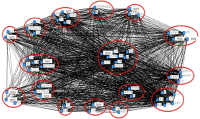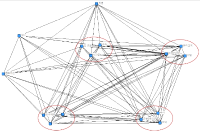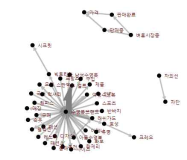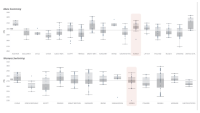PURPOSE This study aimed to identify the factors influencing the success of the sports entertainment program “A Clean Sweep” using big data analysis. METHODS Text mining, sentiment analysis, TF-IDF, connection centrality, and semantic network analysis were conducted using the social big data analysis program Textom and social network analysis program Ucinet6. The research period was limited from June 6, 2022 to November 30, 2023. RESULTS The factors determining success were entertainment programs, Monday, OTT, and independent league. The events and marketing factors were extracted, and A Clean Sweep X Kelly, A Clean Sweep X Mom love, cheering song, uniforms, and direct viewing day influenced success. The new hire factors were rookie draft, Young-Mook Hwang, Sung-Joon Won, and Hyun-Soo Jeong. Positive (such as good, fun, looking forward to, best, and funny) and negative (such as esoteric, regrettable, shocking, dislike, and uncomfortable) emotional factors were also extracted. The extracted star marketing factors were directors (Seung-Yup Lee, Sung-Geun Kim) and players (Dae-Ho Lee, Geun-Woo Jung, Hee-Kwan Yoo, Moon-Ho Kim, Yong-Taek Park, Taek-Geun Lee). CONCLUSIONS We were able to identify the success factors of “A Clean Sweep”, which we hope will contribute to the revitalization of professional baseball as well as sports entertainment programs.
PURPOSE The purpose of this study was to understand the current market trend for golf apparel rental services and to present basic data to revitalize the golf apparel rental service market and prepare continuous growth plans. METHODS The following keywords were selected for data collection: "golf wear + rental (렌탈)," "golf wear + rental (대여)," "golf apparel + rental (렌탈)," and "golf apparel + rental (대여).“ The analysis period was limited to two years and seven months from January 1, 2020 to July 31, 2022, when COVID-19 began. The analysis was focused on the top 60 keywords to simplify the network. RESULTS Various keywords were extracted through text mining, TF-IDF, connection centrality, emotional analysis, and semantic network analysis of big data analysis. These were then categorized into four factors: “golf apparel rental service,” “self-expression and authentication,” “sharing economy,” and “emotion.” CONCLUSIONS The results of this study show that young golfers are unreluctant and are generally positive in renting golf apparel. Therefore, if the growing paradigm of the consumption behavior of MZ-generation golfers is recognized and analyzed and the requirements are continuously satisfied through various strategies, there will be a higher possibility to help expand the golf apparel rental market.
PURPOSE This study aimed to investigate user perceptions regarding the mobile healthcare application of public health centers by using big data. METHODS The study data included 1,089 users’ reviews (from September 27, 2016 to December 23, 2021), which were analyzed using Python, Textom, KrKwic, UCINET 6, and the Net-draw program. RESULTS First, the evaluation of the application showed a higher number of “Good” responses (677 times) compared to “Bad” (329 times) and “Normal” responses (83 times). Second, network structures related to “Good” were “Like,” “Health care,” “Help,” “A sense of purpose,” “Grateful,” “Diet management,” “Exercise management,” “Easy,” “Recommendation,” “Satisfaction,” “Diet,” “Useful,” and so on. Third, network structures related to “Bad” were “Execution error,” “Request improvement,” “Question,” “Slow speed,” “Interlocking error,” “Lack of food type,” “Login error,” “Inconvenience,” “Delete and reinstall,” “Update error,” “Irritation,” “Connection error,” “Problem occurred,” “Direct input request,” “Not available,” “Waste of stars,” “Lack of function,” “Not enough,” “Stuffy,” “Lack of exercise,” and so on. Fourth, as a result of structural equivalence analysis, four clusters appeared: cluster 1 (negative function), cluster 2 (negative emotion), cluster 3 (positive function), and cluster 4 (positive emotion). CONCLUSIONS It is necessary to respond quickly in order to reflect on the users’ reviews, and active efforts are required to improve the program quality so that users can use it conveniently.

Purpose This study reviewed the seriousness of the Match-fixing through the mixed research methods of the big data analysis (quantitative) and the focus group interview (qualitative) using the keyword, ‘Match-fixing’ and discusses the cautious and comprehensive basic direction for coping with negative issues and preventing recurrence. Methods For the quantitative research method, Naver and Daum were used as the analysis channel and the main keywords selected for the data search were ‘Match-fixing’ and ‘Match-fixing+(measures/eradication/solution)’. The data collection period was limited from January 1, 2010 to December 31, 2016. In addition, for the qualitative research method, 6 homogeneous groups (experience, interest, knowledge) related to the research topic were constructed and interviewed using purposive(intentional) sampling. Results First, five factors (emotion, participant, cause, punishment, countermeasure) were categorized by big data analysis. Second, through Focus Croup interview, additional keywords for three factors (emotion, participant, countermeasure) were derived. Conclusions Therefore, it is required that various preventive measures such as emotional reward for negative emotion, preventive and ethical education, advancement of sports, establishment of Match fixing committee, Expert training are needed.




Purpose The purpose of this study was to examine the changing trends of swimsuit perception by using SNS big data. Methods By using “swimsuit” and “swimsuit brand” as key words, data was searched through blogs, cafes, Jisiksin(Tip), news, and web documents provided by naver and daum. This study used 2 years of data from January 1st, 2014 to December 31st, 2015 and social matrix program Textom was used for extracting matrix data and analyze them for frequency. To visualize data networking, NetDraw of UCINET6 program was used. Results Through analyzing the popular link words to the key words, it was known that the key words were 'swimsuit brand', 'children's swimsuit', 'rash guard', 'women's swimsuit', and 'model' in the order in 2014, and ‘swimsuit brand', 'rash guard', 'children's swimsuit', 'women's swimsuit', and 'Arena’ in the order in 2015. Second, the median of connectivity values showed that it was high in ‘swimsuit brand', 'women's swimsuit', 'children's swimsuit', 'rash guard', and 'Arena’ in the order in 2014, and ‘swimsuit brand', 'rash guard', 'women's swimsuit', 'children's swimsuit', and 'Arena’ in the order in 2015. Third, th results of CONCOR analysis demonstrated that ‘female customer’, ‘couple swimsuit’, 'rash guard', ‘brand’, 'children's swimsuit', and ‘fashion’ were grouped in 2014, and ‘brand’, ‘fashion’, 'rash guard', ‘purchase factor', and 'children's swimsuit' were grouped in 2015.







Purpose Soccer-related social media BigData includes complex information related to soccer players and is continuously and instantly generated. Text mining research is actively carried out for this kind of social media contents analysis, but it tends to be analyzed with limited linguistic characteristics such as understanding of language complexity and context, ambiguous terms, rhetoric, and new terms. This can be attributed to the fact that the tools commonly used for text mining use universal terminology dictionaries and packages that exclude the peculiarities of the analysis themes. The purpose of this study is to develop an Ontology model, which are representative tools for defining semantic ambiguity and relationships and systems between terms of text data. Methods In order to achieve the research objectives, we applied the 7-step development method of ‘Ontology Development 101: A Guide to Creating Your First Ontology’, which is useful for ontology development. Each step includes 1) Determine the domain and scope of the ontology 2) Consider reusing existing ontology 3) Enumerate important terms in the ontology 4) Define the classes and the class hierarchy 5) Define the properties of classes-slots 6) Define the facts of the slots 7) Create instances. In particular, the 3rd-step of this study, the glossary stage, is to extract core terms that make up he ontology, but since the goal of this study is to develop the ontology that can be used in social media contents analysis of soccer players, we conducted a social media text analysis related to actual soccer players and selected 484 core terms. Results The ontology which was developed in this research for social media contents analysis of soccer players consisted largely of four parts(General terms, performance results terms, common terms, and Characteristic term) and classified according to the content characteristics of the term. Conclusion Developed ontology in this study is object-oriented that defining classes and objects to define divisions and relationships between terms and also means a social media contents knowledge system of soccer players. In addition, it performs a function as a secondary tool which can be utilized for atypical data analysis.

PURPOSE The purpose of this study was to synthetically explore different communication strategy patterns that are dependent on the events and stakeholders, which include professional sports players, teams, and the associations. METHODS Using the Python program, we performed web crawling and machine learning algorithms to analyze news articles for our research analyses. In particular, 696 articles on driving under the influence (DUI) of alcohol were gathered and subject to descriptive scrutiny; a total of 782 sentences were selected for the analysis. Also, among the 509 articles on illegal gambling, 484 sentences were analyzed. Moreover, 50 frequently reported words were extracted from these sentences to assess their frequencies through the word cloud method for concrete visualization. Then, the data were mapped in order to systemically understand the communication strategy patterns for each case, which were dependent on the stakeholders and timing of the event. RESULTS The empirical results revealed that in case of unethical events of driving under the influence that were reported in the news, most of the subjects chose an apology strategy immediately, but for illegal gambling reports, the parties involved rarely respond and it was difficult to find specific strategy patterns among the subjects. CONCLUSIONS The present study reveals that when professional sports teams were exposed to transgression, depending on the characteristics of the event and stakeholders, they chose different communication strategies involving fan characteristics for the event and subjects. Ultimately, they chose different strategies dependent on their fans’ involvement.
PURPOSE This study was conducted to estimate the tendency of psychological factors influencing cycling performance by analyzing the characteristic factors of athlete reputation in the news big-data. METHODS To explore the psychological factors influencing cycling performance, an open questionnaire was conducted on 82 cyclists, and Inductive Content Analyses was performed. Overall, 89,520 news articles were collected through BIGKinds, and forming factors of athlete reputation were derived through LDA topic modeling analysis and inductive categorization. Through regression analysis, time series tendency of the factors of athlete reputation was calculated. Finally, the tendency of psychological factors to influence cycling performance was estimated based on the previously derived results in this study. RESULTS The psychological factors influencing cycling performance were found to be; emotion control, trust capital, cognitive control, motivation and communications with the coach. The forming factors of athlete reputation was found to be; reporting of the sports event, infrastructure creation, analysis to performance, moral issue, social environmental changes and sports gossip. The time series tendency of the forming factors of athlete reputation was found to include the categories of Hot, Warm, Cool and Cold. The psychological factors influencing cycling performance are estimated to expand to exercise performance and moral intelligence. CONCLUSIONS The results of this study suggest that the discussion of psychological factors influencing cycling performance extends not only to exercise performance, but also to moral intelligence, reflecting the socio-cultural context in the discussion of performance.

Purpose Based on the match data of major judo world competitions in the last five years, this study identifies differences in general characteristics and environmental factors according to scoring technique and scoring times. And by exploring the factors associated with scoring technique, I would like to present a practical strategy that can be used to establish guided tactics. Methods 50,828 points were used for analysis of the entire men and women who competed from 2016 to 2020. Differences in the characteristics of the world's leading athletes according to their types of technique were used in conjunction with the chi-square test and the one-way ANOVA with Sceffe test to produce results. Results The results of this study showed that the type of skill by foot technique was the most common, and the ratio of hand skill to female player to push and foot skill was relatively high. The higher the weight class, the lower the ratio of hand technique, the higher the press rate, and the frequency of skill types also increased. At the Olympic Games, the ratio of hardening technique was higher than that of other competitions, and as the year progressed, the ratio of hand and waist technique increased, and the number of mat-hold decreased. The ratio of hardening technology was relatively high, and the ratio of hand-to-foot technology was relatively high as the semi-final and final rounds were higher. As for technical time, the male athlete's skill time appeared to be about 12 seconds longer on average, with the lowest in the heavyweight class and the longest in the lightweight class. Athletes from the Asian continent appeared to have the longest technical time, which is believed to have resulted from the characteristics of excellent physical strength, good endurance, and strong hardening technique. The skill time leading to the score by pressing and hand skill was the longest, and the waist skill and grip skill time were relatively short. Half of them appeared about 5 seconds shorter on average compared to the first round, and the more important the game (the 4th round, semi-final, and final) the longer the skill time. Conclusion In conclusion, through this study, the characteristics of the world judo players' skill types and time were confirmed, and based on this, it is necessary to analyze and systematize the technical types of the world's best athletes, including Korean athletes, in order to improve their judo performance.



Purpose The purpose of this study was to compare the official world records of UIPM in the last 3 years to find out the relationship between the score characteristics of fencing, swimming, equestrian, and laser-run events in the final rankings and to analyze the relative importance of each event. Methods For 3 years, from 2017 to 2019, a total of the data were collected, the final rankings, fencing conversion scores, swimming conversion scores, equestrian scores, and laser-run conversion scores for all male and female athletes who participated in the UIPM Level 1 World Cup and World Championships(1,197 finals and 2,173 qualifiers). The Multiple regression analysis was used to establish the relationship between the response(subjective) variable and the conversion score of the four explanatory(independent) variables. Results The results were compared by qualification (n = 2173) and final (n = 1197) by dividing into male (n = 1179) and female (n = 1591), and the fencing score was qualifications (male β= -.691, female β= -.533) and the finals (male β= -.632, female β= -.632), it showed the greatest influence in all. On the other hand, the swim score showed the lowest impact on both qualifications (male β=-. 021, female β=-.196) and finals (male β=-. 087, female β=-. 207). The fencing event plays a major role in passing the qualifiers and is a big variable for good performance in the finals. On the other hand, in the case of swimming scores, both men and women had the lowest impact on the final ranking, and there is a limit to the final performance of swimming scores in both qualifiers. Conclusion In conclusion, it is necessary to analyze and systemize the fencing skills of the world’s best athletes, including Korean athletes, to improve the Korean fencing athletes' performance, and through such scientific analysis, a system that enables fast and flexible responses to the upcoming Olympic. Additionally, even though the importance of all sports should be levelled due to the characteristics of modern pentathlon, relative importance is biased toward fencing and swimming events are neglected. Therefore, it is deemed necessary to conduct a follow-up study on whether the scoring system in modern pentathlon consists of a scoring system that supports the records of each event and the upper and lower scoring system.




